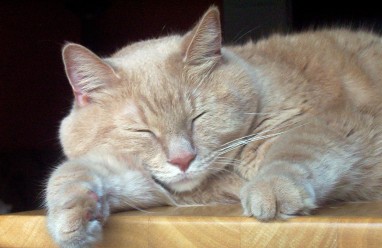

How does the heart work?
The heart is made up of 4 chambers - the left and right atriums (upper chambers) and left and right ventricles (lower chambers). The blood flows from the body into the right atrium then on into the right ventricle. The right ventricle then pumps the blood into the lungs where it is oxygenated. The blood then flows into the left atrium then onto the left ventricle which pumps it around the body.
What is heart disease?
Heart disease can either be acquired or congenital. The vast majority of heart diseases in dogs and cats are acquired.
Congenital heart disease is usually diagnosed when the animal is very young and includes conditions such as Patent Ductus Arteriosus (PDA) and Pulmonary Stenosis. A referral to a veterinary specialist is usually required for management of these diseases.
Acquired heart disease involves either disease with a damaged heart valve (valvular insufficiency), disease with heart muscle abnormalities or other causes including heartworm infection.
In dogs, the most common heart diseases are Mitral Valve Insufficiency and Dilated Cardiomyopathy. In cats, the most common heart disease is Hypertrophic Cardiomyopathy.

Mitral Valve Insufficiency
Mitral valve disease is the main heart disease that we see in dogs and most commonly affects smaller breeds of dog. Some breeds are more susceptible to mitral valve disease with Cavalier King Charles Spaniels the most commonly affected breed.
In Mitral Valve Insufficiency, the mitral valve (the heart valve between the left atrium and left ventricle) does not seal properly and becomes leaky. This causes a heart murmur which can be heard when the dog’s chest is listened to with a stethoscope. This may be detected by the Vet during a routine examination and may be the first sign of a problem with the dog’s heart.
Over time, the blood leaking backwards through the abnormal mitral valve increases the workload on the heart which in turn results in reduced efficiency of the heart and structural changes in the heart. Blood backs up into the lungs and results in pulmonary oedema (fluid in the lungs) and heart failure.
Not all dogs with heart murmurs go on to develop heart failure. From the time a murmur develops it can take months to years for heart failure to develop.
Dilated Cardiomyopathy
Dilated cardiomyopathy can be seen in both dogs and cats but is far more commonly seen in dogs. Certain breeds such as Dobermann Pinschers are predisposed. Diet can also contribute to development of this condition and recently there has been a suspected link between the feeding of grain-free diets and dilated cardiomyopathy.
Read more from the FDA here. (https://www.fda.gov/AnimalVeterinary/NewsEvents/CVMUpdates/ucm613305.htm).
In Dilated Cardiomyopathy, the heart muscle wall becomes thin and results in inability of the heart to pump blood efficiently. This results in heart failure with fluid building up in the lungs or body.

Hypertrophic Cardiomyopathy
Hypertrophic Cardiomyopathy is the most common form of heart disease seen in cats. The muscle of the heart thickens and stops the heart from functioning efficiently.
Signs of heart disease can include:
These signs can be seen with other diseases and it may be necessary for the Vet to perform certain examinations or tests to obtain an accurate diagnosis.
Tests to assess and diagnose heart disease include:
Some heart diseases can be mild and may not cause any signs of disease. An accurate diagnosis is important so that the optimal treatment for each individual animal can be achieved. With the correct treatment, many animals are able to live a normal life for many months to years.